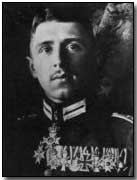The War in the Air - Fighters: The Fokker Scourge
 In spite of its innovative use of deflector gear the German Eindecker was in many ways an unexceptional aircraft.
In spite of its innovative use of deflector gear the German Eindecker was in many ways an unexceptional aircraft.
In April of 1916 a captured Eindecker was tested by the Allies, and found to be inferior in performance to its Morane-Saulnier opposite number. The interrupter gear was also far from perfect - both Boelcke and Immelmann survived shooting off their own propeller.
The impact of the interrupter-gear Eindecker, however, was enormous. The heretofore appreciated stability of the Allied aircraft became a liability as they could not escape the more manoeuvrable Eindecker. The French were forced to curtail their successful day bombing operations and turn to night bombing. The RFC began to suffer losses approaching two a day.
The great German offensive against Verdun began in early 1916. In accordance with the German plan to bleed the French army dry, Falkenhayn determined to use their control of the air to do the same thing to the Armee de l'Air, and to blind the French artillery by shooting their observer aircraft out of the skies.
Boelcke, who had done much to develop the tactics of aerial warfare, was moved to Rethel, nearer to Verdun, to command a new Kampfeinsitzerkommando - a single seater detachment. Immelmann remained in command at Douia.
For the opening six months of 1916 the Germans maintained control of the air. It was wrested from their grasp, but slowly. By the opening of the Battle of the Somme in July, the Eindecker was obsolete. Boelcke was to refer to July and August of 1916 as "the blackest days in the history of German military aviation."
The Eindecker, ironically, was unseated by aircraft already available before Fokker's invention of the interrupter gear, and none of them ever had interrupter gear installed. It was the combination of four types of aircraft that defeated the Eindecker.
Three of them were British, and they were all pusher aircraft - the Gun Bus, the FE2b, and the DH2. The fourth was the altogether far more impressive French Nieuport 11 "Bebe" (Baby). This was a tractor sesquiplane (a biplane, but with the lower wing significantly smaller than the upper wing.)
Its armament consisted of a Hotchkiss or Lewis gun mounted on the upper wing, much in the same configuration as that tried out by Louis Strange, but on a sliding mount allowing the pilot to pull the machine gun down towards him. This was intended to allow the pilot to shoot upwards at an angle, in addition to removing the need to stand when reloading or servicing the weapon.
The French officially adopted the "ace" system during the battle of Verdun. Many of these pilots were concentrated in a famous squadron, the Cigognes (Storks), and the aces Navarre, Nungesser and Guynemer, all flying Nieuports, became household names.
It was not just the aircraft themselves that returned control of the air to the Allies. It was only during 1916 that these aircraft appeared at the front in significant numbers and that they were organized into fighter units.
The Allies, with the French taking the lead, learned the value of flying in defensive formations of four to five aircraft, matching the three to four plane offensive patrols of the Germans.
If the Fokker Scourge was symbolically opened by Boelcke's first victory, it was symbolically closed when Max Immelmann was killed during a fight with an FE2b on June 18th 1916. Whether he was shot down, as claimed by the Allies, or shot away his own propeller, as claimed by the Germans, is still a matter of debate.
Article contributed by Ari Unikoski
Next - Fighters - Spad, Pup and Albatross, the Intermediate Generation
In WW1 an "ace" was a pilot who scored five confirmed "kills".
- Did you know?
